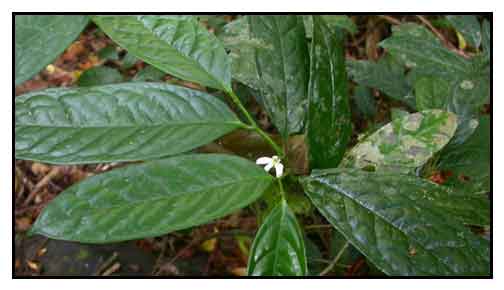 Botany Botany
Dalairo is a low undershrub. Leaves are oblong, 7 to 15 centimeters long, 3 to 5 centimeters wide, smooth, and obtuse at the ends. Flower is solitary, leaf-opposed, and about 2 centimeters in diameter. Sepals are ovate, and the petals ovate or oblong. Fruit is clavate, and 3 to 4 centimeters long. Seeds are shining, black, and obovoid.
Distribution
- In forests chiefly at medium altitudes, locally abundant in Bataan, Laguna, Cavite, Batangas, and Camarines Provinces in Luzon; and in Mindoro; Biliran; Leyte; Negros; and Mindanao.
- Also occurs in Sri Lanka, Burma, Sumatra, the Malay Peninsula, Indo-China, and Java.
 Constituents Constituents
- Study yielded prenylflavonoids.
- Study of bark yielded five new xanthones, 1,3,6-trihydroxy-5-methoxy-4-prenylxanthone (1), 1,3,5-trihydroxy-6-methoxy-2-prenylxanthone (2), 1,3,5-trihydroxy-4-(3-hydroxy-3-methylbutyl) xanthone (3), 1,3,6-trihydroxy-4-prenylxanthone (4), 3,6-dihydroxy-1,5-dimethoxyxanthone (5) and one new flavonoid, 3,5,7,4'-tetrahydroxy-2'-methoxyflavone (6) along with seven known xanthones and seven known flavonoids. (See study below) (2)
- Yields phytoestrogen 8-Isopentenylnaringenin (prenylflavonoid).
- Phytochemical screening of hexane, DCM, and EA extracts isolated five compounds viz. three xanthones,
1,6-dihydroxy-5-methoxy-4',5'-dihydro-4',4',5'- trimethyl-furano-(2',3':3,4)-xanthone (1), 2-deprenyl-rheediaxanthone B (2) and 1,3,6-trihydroxy-5-methoxyxanthone (3) and the two flavonols, kaempferol (4) and quercetin (5). (see study below) (4)
- Study of bark yielded five new xanthones, 1,3,6-trihydroxy-5-methoxy-4-prenylxanthone (1), 1,3,5-trihydroxy-6-methoxy-2-prenylxanthone (2), 1,3,5-trihydroxy-4-(3-hydroxy-3-methylbutyl) xanthone (3), 1,3,6-trihydroxy-4-prenylxanthone (4), 3,6-dihydroxy-1,5-dimethoxyxanthone (5) and one new flavonoid, 3,5,7,4'-tetrahydroxy-2'-methoxyflavone (6) along with seven known xanthones and seven known flavonoids. (see study below) (11)
Properties
- Considered tonic, stomachic, antipyretic.
- Studies have suggested antioxidant, vasorelaxant, tyrosinase inhibitory, estrogen agonist, antimicrobial, cholinesterase inhibitory, phosphodiesterase inhibitory properties.
Parts used
Leaves.
Uses
Folkloric
- Fresh leaves used as topical for articular rheumatism.
- In Thailand, used as a traditional medicine as a blood tonic, stomachic, antipyretic and treatment of muscular pain.
- Leaves used in the treatment of erectile dysfunction.
Others
• Erectile dysfunction: Marketed as: (1) blood tonic and muscle strengthening properties. (2) as herbal supplement for erectile dysfunction or impotence problems.
Studies
• Constituents / Antioxidant: Study of the bark of A. luzonensis yielded five new xanthones and one new flavonoid, along with seven known xanthones and seven known flavonoids. Almost all the flavonoids and one xanthone showed antioxidant activity. Compound 6, new flavonoid (3,5,7,4'-tetrahydroxy-2'-methoxyflavone), scavenged the DPPH radical to the same degree as a-tocopherol. Almost all flavonoids and one xanthone (13) showed antioxidant activity. (see constituents above) (2)
• Constituents / Antioxidant: A new flavonoid, 3,5,7,4'-tetrahydroxy-2'-methoxyflavone, isolated on autoxidation of epinephrine Hcl exhibited an effective antioxidant potency. (1)
• Vasorelaxant / Antioxidant: Study of dichloromethane extract of Anaxagorea luzonensis showed concentration-dependent vasorelaxation. Results in the rat isolated aorta showed vasorelaxant responses, in part, mediated via the endothelium and NO-dependent pathways. Results provide evidence to support it use as a vasodilator agent. (3)
• Tyrosinase Inhibition / Antioxidant / Stems: Study evaluated phytochemicals and anti-tyrosinase activities of A. luzonensis stems. Hexane, diichlormethane, and ethyl acetate extracts were found active against mushroom tyrosinase with percent inhibition at 0.909 mg/ml of 28.56%, 58.27%, and 86.76%. respectively. Antioxidant studies on the extracts showed IC50 values of 162.7, 10.60, and 3.33 µg/ml, respectively. Results demonstrate potential of A. luzonensis as tyrosinase inhibitory and antioxidant agents for pharmaceutical and cosmetic applications. (see constituents above) (4)
• Prenylflavonoids / Estrogen Agonist Activity: Study isolated 8-isopentenylnaringenin that exhibited an estrogen agonist activity at an order greater than genistein. (5)
• Xanthones / Cholinesterase Inhibitory Activity: Heartwood yielded five xanthones. Xanthone 3, 1,3,5-trihydroxy-4-prenylxanthone, exhibited the highest in vitro activity against acetylcholinesterase (AChE) and butyrlcholinesterase (BChE). Through enhancement of neurotransmitter acetylcholine (ACh) in the brain, cholinesterase inhibitory activity may have an important role in the treatment of Alzheimer's disease. (7)
• Antimicrobial Activity / Essential Oils: Study evaluated the essential oils from underground parts (roots and rhizomes) and aerial parts (stems, leaves, and flowers). Main constituents of aerial part oil were toluene, tetradecanoic acid, linalool, and caryophyllene oxide; underground parts were caryophyllene oxide, ß-damascenone, and ß-ionone. Essential oils from the root exhibited high antimicrobial activity against human pathogen K. pneumoniae. Essential oil of aerial parts displayed varying activity against all tested strains. (8)
• Acute Oral Toxicity Testing: Study evaluated the safety of 95% ethanolic extract of Anaxagorea luzonensis and Ziziphus attopensis in rats. Results showed the extracts are safe to use as a material source for herbal drug development. (9)
• Flavonoids and Xanthones / Antioxidants: Study of bark of Anaxagorea luzonensis yielded five new xanthones and one new flavonoid, along with seven known xanthones and seven known flavonoids. Almost all flavonoids and one xanthone showed antioxidant activity. (see constituents above) (11)
• Phosphodiesterase Inhibitory Activity: Study isolated five flavonoids, one isoflavone and five xanthones. Of the eleven isolated compounds, 1,3,5-trihydroxy-4-prenylxanthone (3) showed to be a relatively potent inhibitor of phosphodiesterase type 5 (PDE5), with an IC50 value of 3.0 µM. The presence of the C-4 prenyl residue attached to the xanthone core is correlated with the significant PDE5 inhibitory activity. (12)
• Cholinesterase Inhibitory Activity of Xanthones/ Heartwood: Study isolated five xanthones from the heartwood of A. luzonensis. Xanthone 3 (1,3,5-trihydroxy-4-prenylxanthone) showed highest in vitro inhibitory activity against acetylcholinesterase (AChE) and butyrylcholinesterase (BChE). (13)
• Xanthones / Potential PDE5 Inhibition: Research has shown Anaxagorea spp. to be a promising source of xanthone. Study isolated 1,3,5-trihydroxy-4-prenylxanthone 1 from A. luzonensis heartwood extracts. Phosphodiesterase type 5 (PDE5) inhibitory activity of this compound showed an IC50 of 3.0 µM. PDE5 has a recognized role in several human syndromes, including erectile dysfunction, and is a target of drugs used in the treatment of male sexual dysfunction i.e., sildenafil, vardenafil, tadalafil, and avanafil. (14)
Availability
- Wild-crafted.
- Capsules in the cybermarket; marketed for erectile dysfunction. |

![]()





